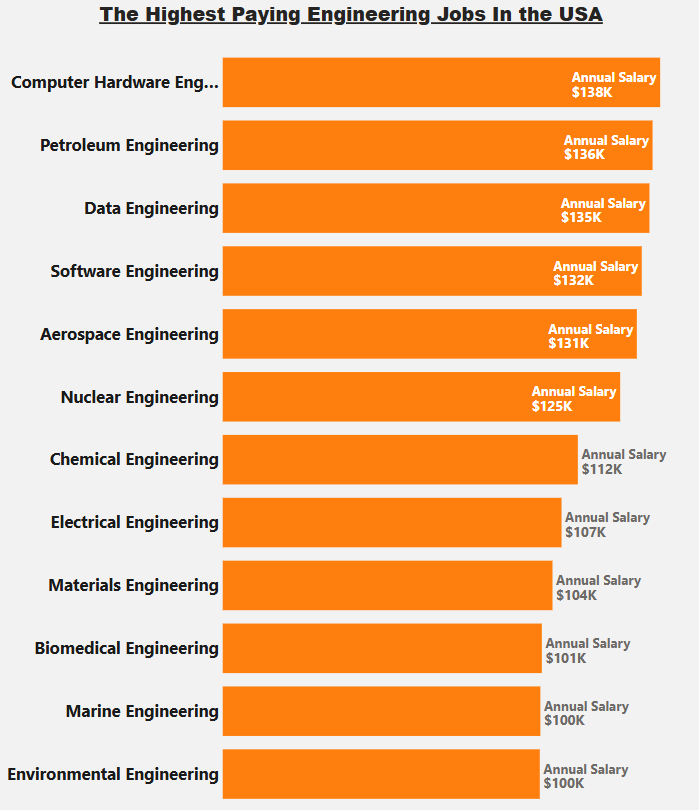
Engineering enrollment trends for international students demonstrate the dynamic interplay between financial supports, career aspirations, and global education. As the salaries in engineering fields are high, they remain a popular choice for international students. This industry promises innovation, problem-solving, and the chance to shape the future of engineering and technology. For many, it is a path to stability and advancement. The appeal of engineering transcends academia and is strongly tied to practical implications, like engineering employment opportunities. Because so many international students are considering engineering programs, engineering enrollment reflects broader trends than other fields. This blog walks you through engineering enrollment trends and the factors influencing them.
Why Engineering Enrollment Trends Matter
A Global Perspective on Student Mobility
Trends in engineering enrollment offer insight into how students travel abroad to pursue tertiary degrees. International students have shown a consistent interest in engineering degrees in countries including the US, Canada, the UK, Australia, and Germany in recent years. These countries attract aspirational students with their thriving companies and state-of-the-art research. Additionally, many students base their decisions on factors beyond academic performance, such as their future employability. The engineering majors are more appealing due to their competitive salaries. Universities can better customize outreach and support by having a better understanding of these tendencies.
Economic and Social Impacts
Globally, engineering enrollment trends have an impact on economies and communities. Particularly, international students frequently close significant skill gaps in their host countries. Their efforts, whether through labor involvement or innovation, have a positive knock-on effect, enhancing sectors like infrastructure and technology. As a result, enrollment data becomes more than just numbers. Beyond economics, these students promote intercultural dialogue and enhance campus diversity. Many are motivated by the prospect of earning a high engineering salary, but the wider effects are significant. Following these trends demonstrates how they are influencing a globalized society.

Key Drivers of Engineering Enrollment Trends
Engineering Salary High Ranges
Most engineering-related jobs in the US offer a median salary of at least $100,000 in 2025. A comprehensive salary guide highlights the highest paying engineering jobs in the country for the year 2025. The data in the image below presents the top 12 highest paying engineering jobs, compiled through an analysis of thousands of publicly available listings across the US. Key factors such as salary, education requirements, experience levels, seniority titles, and job locations were examined to identify trends and determine both average and median figures. The analysis was last updated in May 2025. Michigan Tech also provides a detailed table that includes Mean Entry-Level Salary, Mean Annual Salary, and Top 10 Percent earnings across 24 different engineering fields.

Academic Reputation and Program Quality
The standing of academic institutions is one of the main factors influencing engineering enrollment patterns. With their top-notch faculty and facilities, prestigious universities like MIT, Stanford, Oxford, Cambridge, Melbourne, the Technical University of Munich, and ETH Zurich draw international students. These institutions’ research programs promise access to cutting-edge research and demanding training. Talent is attracted to high-quality education. Students often think about how these certifications will affect their post-graduation engineering pay. Enrollment decisions are influenced by the fact that prestigious degrees frequently lead to rich professions. Universities improve their offerings to keep ahead of the competition as it increases.
Visa Policies and Immigration Pathways
Visa policies have a big impact on international engineering student enrollment trends. Countries that offer flexible post-study employment options and student visas, like Canada’s Post-Graduation Work Permit, have higher engineering enrollment rates. These options offer a chance to stay and build a career after graduation. Accessibility is crucial. Conversely, restrictive rules might deter students and alter trends in other places. The prospect of earning an engineering salary in a stable economy is what motivates this movement. Thus, trends in engineering enrollment are significantly influenced by immigration frameworks. They serve as a gatekeeper for opportunities.

Engineering Enrollment Trends by Region
North America’s Dominance
Engineering enrollment trends for international students have historically been dominated by North America, especially the United States. Because of the country’s innovation hubs and research funding, more than 200,000 international students studied engineering in the United States in 2022–2023. With programs that prioritize practical skills, Canada has also experienced growth. Enrollment is strong due to the high potential for engineering salaries in Silicon Valley or Toronto. However, current uncertainty surrounding visas has caused volatility, leading some students to look into other options. Though patterns are changing, North America is still a major force.
Europe’s Rising Appeal
With countries like Germany and the UK at the forefront, Europe is catching up in engineering enrollment trends. Every year, thousands of people are drawn to Germany by its robust industrial base and tuition-free public colleges. Despite Brexit, the UK’s engineering heritage and international connections continue to attract students. Europe is competitive due to its reasonable educational costs and promising engineering job prospects. Automation and renewable energy programs meet market demands and increase enrollment. These engineering enrollment trends are reshaped by Europe’s fusion of innovation and tradition. Another reason overseas students choose to study engineering in Europe is the availability of European financial assistance opportunities, including Erasmus Mundus Scholarships, Marie Curie PhD Scholarships, and British Council Scholarships.
Challenges Impacting Engineering Enrollment Trends
Financial Barriers and Cost of Education
The cost of programs continues to be a barrier to engineering enrollment trends for international students. Tuition, living expenses, and travel add up, especially in places with high demand, like the USA or Australia. Even though financial aid and scholarships are beneficial, many students still face financial difficulties. Accessibility varies. Some people are deterred by upfront costs, but perseverance is encouraged by the possibility of earning an engineering salary in the future. Students on a tight budget are more likely to enroll in schools that provide financial aid or programs at affordable prices. Fixing this problem could alter patterns. Leveling the playing field is the aim.
Cultural and Language Adjustments
Language and cultural adaptation also affect engineering enrollment trends. Students moving to English-speaking countries or regions with unique dialects, like Germany’s technical German, face steep learning curves. These challenges may affect where they choose to study. Adaptation requires effort. This transition is facilitated and enrollment is maintained by support systems like language classes or mentorship. A welcoming environment aids students in overcoming challenges and realizing their goals for engineering salaries. Cultural fluency is part of the journey.
Future of Engineering Enrollment Trends
Emerging Fields and Specializations
Future engineering enrollment trends are driven by emerging fields such as sustainable engineering and artificial intelligence. Programs that promise innovation and relevance, e.g., think machine learning or green tech, are attractive to international students. These regions indicate the direction of industries. The future is specialized. The need for expertise in these areas is closely related to the rise in engineering salaries, which draws progressive individuals. Enrollment increases at universities that modify their courses to incorporate this expertise. These cutting-edge fields will be the ones to follow trends.
Technology and Virtual Learning
Through online and hybrid programs, technology is changing the engineering enrollment trends. Virtual courses enable international students to enroll at prestigious universities without relocation. This adaptability increases accessibility, particularly in light of financial constraints or travel limitations. Digital education is revolutionary. Remote learning develops abilities for future success, even though it can postpone immediate increases in engineering salaries. Universities that combine in-person and online programs (e.g., online PhD programs) serve various needs, which affects engineering enrollment trends.

How Students Navigate Engineering Enrollment Trends
Research and Decision-Making
Selecting the best engineering program for international students requires meticulous planning and in-depth research. With so many alternatives, students evaluate alumni job paths, faculty specialization, and program rankings to find the one that best suits their goals. The choice affects long-term employment possibilities in addition to academic prestige. Internet resources are very important. While internet forums, student reviews, and LinkedIn connections offer real-time insights from individuals presently enrolled, university websites, faculty profiles, and research publications assist students in assessing the academic environment. Through these platforms, students can evaluate the caliber of instruction, industry contacts, and experiential learning possibilities.
Future earning potential is one of the most important elements determining enrollment decisions. Graduates in engineering frequently look for institutions with good employment placement rates and promising pay. Decision-making also extensively considers post-graduation employment prospects, visa regulations, and university support services like networking events and career counseling. Students are guaranteed to match their academic decisions with their personal and professional goals thanks to this methodical, research-based approach. The collective choices of students who value strategic planning over whims are reflected in the changing patterns in engineering enrollment.
Community and Peer Influence
Engineering enrollment trends are greatly influenced by peer networks and personal relationships, which can have an equal impact as official rankings or pay information. Stories from friends, relatives, and former students who studied overseas might serve as strong inspiration for others to pursue similar careers. This effect is amplified by social media. Students can discuss their academic adventures, campus experiences, and even engineering pay milestones on platforms like YouTube, Instagram, and LinkedIn. Prospective applicants are influenced by these first-hand stories that vividly depict what life is like at prestigious engineering schools.
An entire community may be persuaded to choose the same institution by a single success story, like landing a desired internship at a well-known software company. In addition to social media, reliable information sources include university ambassadors, student forums, and WhatsApp and Telegram groups. These networks provide engineering students with information about college culture, application advice, and visa guidance.
Engineering enrollment trends in particular countries or institutions are reinforced by this word-of-mouth phenomenon. Future candidates from the same neighborhoods are more likely to apply if a university establishes a reputation for having good job placements or an inclusive student body. In the end, choosing to enroll in engineering is a group process that is influenced by interpersonal relationships and common goals rather than being solely an individual choice.

Conclusion
International student enrollment trends in engineering demonstrate a potent fusion of economic foresight, global mobility, and career ambition. High earning potential, program quality, and immigration pathways continue to draw students from all over the world as the need for qualified engineers grows. However, decision-making becomes more difficult due to changing specializations, cultural adaptations, and financial constraints. Peer networks and online communities, in addition to institutions and policies, also influence these trends. Universities that adjust swiftly will be able to compete as new fields and online learning expand. In the end, being aware of these trends aids students in making wise decisions and enables educational institutions to better assist the upcoming generation of international engineers.
Frequently Asked Questions (FAQs)
Why do international students choose engineering programs?
Because engineering offers high salaries, strong job prospects, and opportunities to work on innovative projects that impact the future.
How do visa policies affect engineering enrollment?
Flexible visa policies and post-study work options increase enrollment, while restrictive rules can discourage international students.
What role does peer influence play in enrollment trends?
Word-of-mouth, social media, and personal networks strongly shape students’ choices by sharing real experiences and success stories.



Leave Your Comment